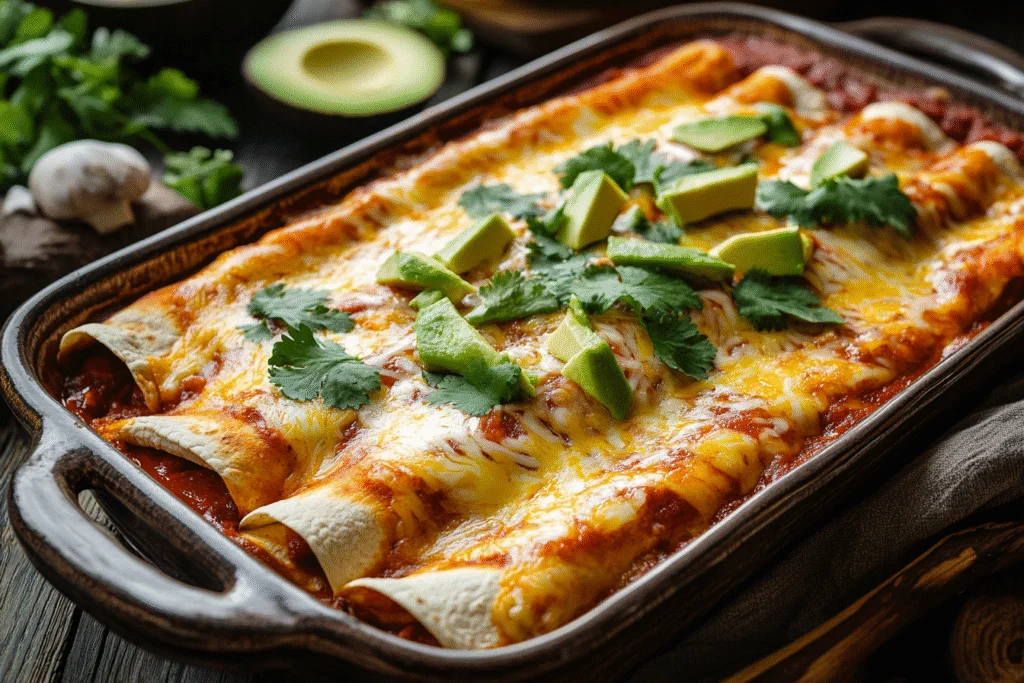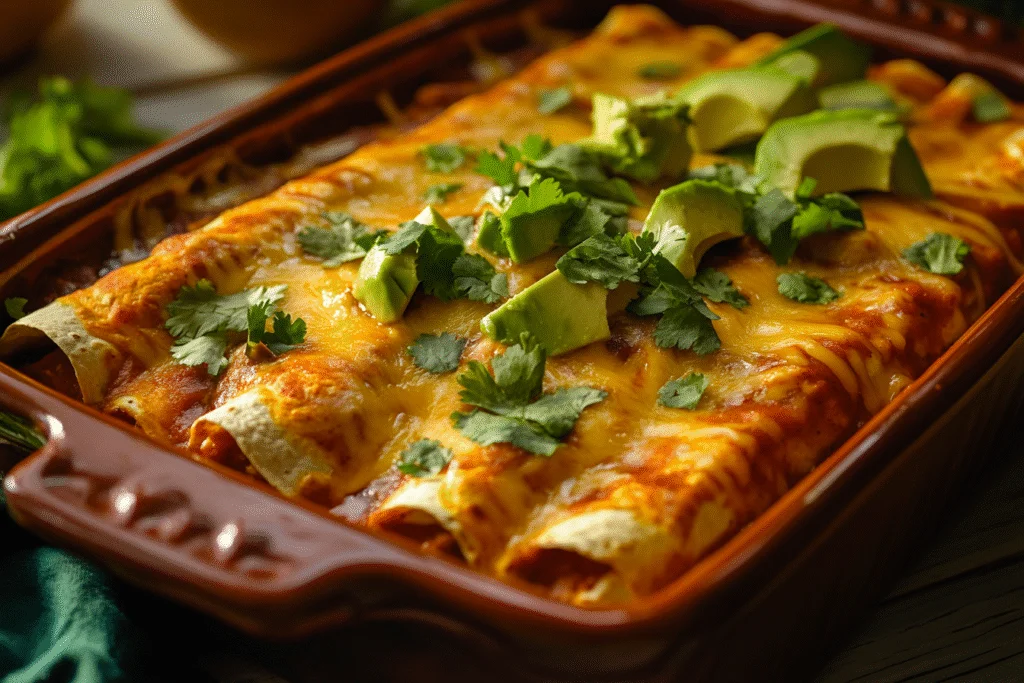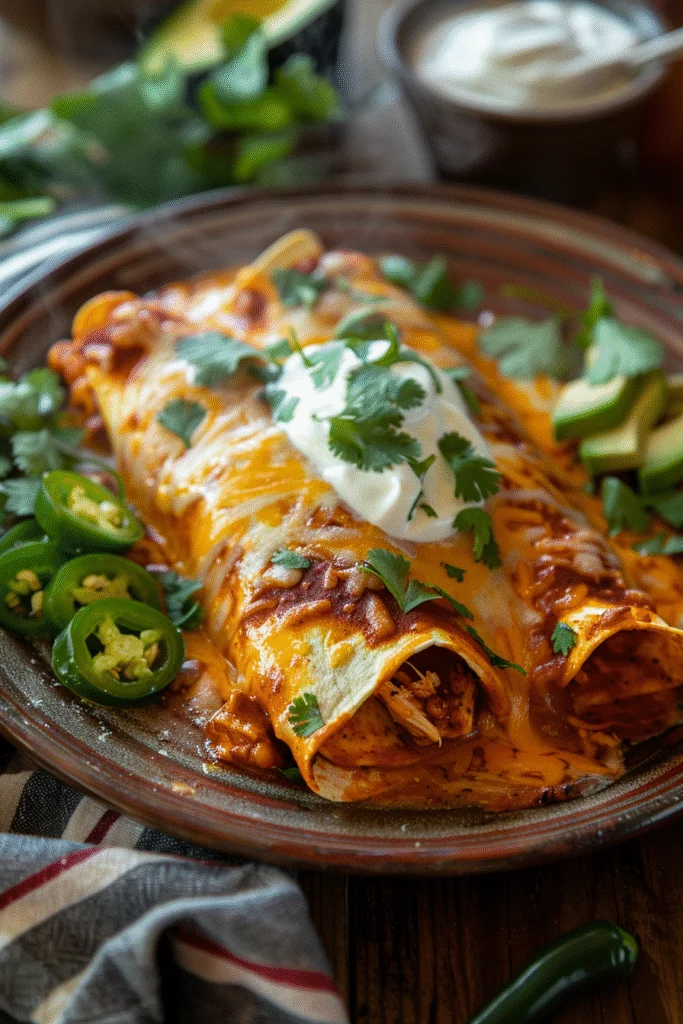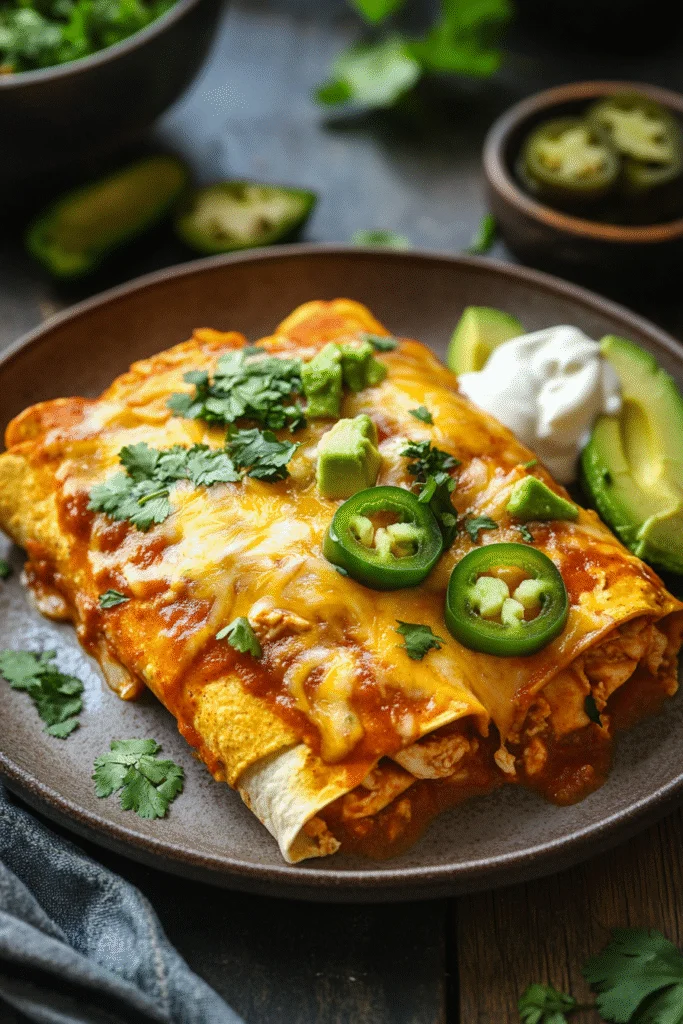Few dishes bring comfort, flavor, and versatility together quite like Chicken Enchiladas. Whether you’re planning a cozy family dinner, prepping for a potluck, or simply craving a satisfying Mexican-inspired meal, this dish delivers every time. Tender shredded chicken is enveloped in soft tortillas, bathed in a rich, savory enchilada sauce, and baked under a golden, bubbling blanket of cheese. The beauty of chicken enchiladas lies not just in their irresistible taste but in their adaptability—this is a dish you can truly make your own.
In this detailed recipe guide, we’ll dive deep into every aspect of crafting the perfect chicken enchiladas. From selecting the right ingredients and equipment to solving common challenges and offering creative substitutions, I’ll walk you through each step to ensure your enchiladas are a delicious success.
Understanding the Heart of the Dish: What Makes Chicken Enchiladas Special?
Chicken enchiladas are more than just a comforting, cheesy meal—they are a celebration of balance. The combination of textures and flavors is what makes them shine. The soft, slightly chewy tortillas provide a perfect vehicle for the juicy, well-seasoned chicken, while the enchilada sauce (whether red or green) brings layers of smoky, tangy, and slightly spicy flavors that soak into every bite. The melted cheese on top ties everything together, adding creaminess and richness.
What sets homemade enchiladas apart from restaurant versions or store-bought kits is the ability to control each component: the seasoning of the chicken, the type of tortillas, the spice level of the sauce, and even the style of cheese. This control allows you to craft enchiladas that suit your taste perfectly—mild or spicy, saucy or lightly coated, classic or with a creative twist.

Common Challenges and How to Avoid Them
Even though chicken enchiladas are relatively straightforward, there are a few pitfalls that can trip up home cooks. Let’s look at the most common issues and how to prevent them:
1. Soggy Enchiladas
- Cause: Overly wet fillings or excessive sauce can cause the tortillas to break down during baking.
- Solution: Use well-drained chicken and avoid over-saturating with sauce before baking. Lightly frying the tortillas before rolling can also create a protective layer that resists sogginess.
2. Dry Chicken
- Cause: Overcooked chicken or using lean breast meat without enough moisture can make the filling dry.
- Solution: Use poached or rotisserie chicken, and mix it with a bit of enchilada sauce or sour cream to keep it moist.
3. Tortillas Breaking
- Cause: Cold or dry tortillas crack when rolled.
- Solution: Warm the tortillas before assembly, either briefly in a skillet, microwave, or wrapped in foil in the oven.
4. Uneven Baking
- Cause: Crowding the baking dish can prevent even heat distribution.
- Solution: Leave a little space between enchiladas and ensure they are in a single, even layer.

Ingredient Selection: Building Flavor from the Ground Up
The key to exceptional chicken enchiladas is using quality, fresh ingredients and understanding how each contributes to the final dish.
Chicken: Freshly Cooked or Rotisserie?
You can use freshly poached chicken, leftover roasted chicken, or a store-bought rotisserie chicken for convenience. Thighs provide more flavor and moisture, but breast meat works well when mixed with sauce or cheese.
Tortillas: Corn vs. Flour
- Corn tortillas offer the most authentic flavor and texture, but they’re more fragile.
- Flour tortillas are sturdier and easier to roll, but they can become gummy if oversauced.
Enchilada Sauce: Homemade or Store-Bought
Homemade enchilada sauce—whether red with chili powder or green with tomatillos—offers the best depth of flavor. However, there are excellent store-bought options. Look for sauces with minimal preservatives and real chili flavor.
Cheese: Melty and Flavorful
A blend of Monterey Jack and cheddar is classic, but you can experiment with pepper jack for spice or Oaxaca cheese for authenticity.

Essential Equipment for Seamless Preparation
Having the right tools makes a big difference in how smoothly your enchilada-making process goes:
- Large Skillet or Saucepan: For preparing the filling.
- 9×13-Inch Baking Dish: Perfect size for a standard batch.
- Mixing Bowls: For tossing chicken with sauce and cheese.
- Tongs or Slotted Spoon: For handling hot tortillas.
- Small Skillet: To warm tortillas and prevent breakage.
- Aluminum Foil: To cover enchiladas during the first part of baking to retain moisture.
Ingredient Substitutions for Every Dietary Need
Whether you’re cooking for dietary restrictions or simply prefer a twist on the classic, here are some easy swaps:
- Gluten-Free: Use certified gluten-free corn tortillas and double-check your enchilada sauce ingredients.
- Dairy-Free: Replace cheese with plant-based alternatives and use dairy-free sour cream.
- Low-Carb: Try low-carb tortillas or substitute thinly sliced zucchini for the wraps.
- Vegetarian: Swap chicken for black beans, sautéed vegetables, or a mix of beans and corn.

Preparation Strategies: How to Work Efficiently
1. Prep Ahead:
Cook and shred the chicken, grate the cheese, and prepare or measure out the sauce up to two days in advance. You can also assemble the entire dish a day ahead and refrigerate until baking.
2. Warm Tortillas Properly:
Microwave the tortillas under a damp paper towel for 30 seconds or quickly pan-fry each side in a bit of oil. This makes them more pliable and less likely to crack.
3. Roll Tightly, But Not Too Tight:
A snug roll keeps the filling in place, but overstuffing or rolling too tightly can cause the tortilla to tear.
Flavor Boosts and Creative Variations
If you’d like to elevate your enchiladas beyond the classic version, try these flavorful additions:
- Add a layer of refried beans inside each tortilla for heartiness.
- Mix a little chipotle in adobo sauce into the enchilada sauce for smoky heat.
- Stir chopped green chiles or roasted corn into the chicken filling.
- Top with fresh garnishes like avocado slices, pickled red onions, cilantro, or crumbled queso fresco just before serving.
Chicken Enchiladas Recipe
Ingredients
For the Chicken Filling:
- 3 cups cooked, shredded chicken (about 1 rotisserie chicken)
- 1 cup shredded Monterey Jack cheese
- ½ cup sour cream
- ½ cup enchilada sauce
- 1 (4-ounce) can diced green chiles (optional)
- ½ teaspoon ground cumin
- ½ teaspoon garlic powder
- ¼ teaspoon salt
- ¼ teaspoon black pepper
For Assembly:
- 10 small corn tortillas (or flour tortillas)
- 2 cups enchilada sauce (homemade or store-bought)
- 1½ cups shredded cheddar cheese (or Monterey Jack)
- 2 tablespoons vegetable oil (for softening tortillas)
For Garnish:
- Fresh cilantro, chopped
- Sliced avocado
- Sour cream
- Pickled jalapeños (optional)
Step-by-Step Instructions
1. Preheat and Prep
Preheat your oven to 375°F (190°C). Lightly grease a 9×13-inch baking dish and set aside.
2. Prepare the Chicken Filling
In a large bowl, combine the shredded chicken, 1 cup Monterey Jack cheese, sour cream, ½ cup enchilada sauce, green chiles (if using), cumin, garlic powder, salt, and pepper. Mix well until all ingredients are evenly coated and the filling is creamy and cohesive.
Tip: The sour cream adds moisture, helping prevent the chicken from drying out during baking.
3. Warm the Tortillas
Heat a small skillet over medium heat. Add a few drops of vegetable oil and quickly warm each tortilla for about 10-15 seconds per side until soft and pliable. Stack the warmed tortillas and cover with a clean towel to keep them warm and flexible.
Tip: Skipping this step can lead to cracking when you roll the enchiladas.
4. Assemble the Enchiladas
Spread ½ cup enchilada sauce evenly across the bottom of the baking dish.
Working with one tortilla at a time, place about 3 tablespoons of the chicken filling in the center. Roll the tortilla snugly and place it seam-side down in the prepared dish. Repeat until all tortillas are filled and arranged in a single layer.
5. Sauce and Cheese
Pour the remaining enchilada sauce over the top of the rolled tortillas, making sure to coat them evenly. Sprinkle the cheddar cheese generously over the entire dish.
6. Bake
Cover the dish loosely with aluminum foil and bake for 20 minutes. Remove the foil and bake for an additional 10-15 minutes, until the cheese is melted and bubbly and the edges are lightly golden.
7. Garnish and Serve
Let the enchiladas rest for 5 minutes before serving. Garnish with fresh cilantro, sliced avocado, extra sour cream, or pickled jalapeños as desired.
Troubleshooting Tips
- Tortillas Tearing? Make sure to warm them properly and don’t overfill.
- Too Dry? Add a bit more sauce over the top or mix a little more sour cream into the filling next time.
- Soggy Enchiladas? Lightly fry the tortillas or reduce the amount of sauce poured over the top.
Variations: Enchiladas vs. Casserole vs. Chimichangas
- Chicken Enchiladas: Rolled, sauced, and baked—soft and comforting.
- Enchilada Casserole: Layered like lasagna for faster assembly—great for feeding a crowd.
- Chimichangas: Deep-fried burritos, often served crispy with sauce on the side.
Storage, Reheating, and Make-Ahead Tips
Storage:
- Refrigerate leftovers in an airtight container for up to 4 days.
Freezing:
- Assemble enchiladas in a freezer-safe dish without baking.
- Cover tightly and freeze for up to 3 months.
- Bake from frozen, covered, at 375°F for 45-50 minutes.
Reheating:
- Reheat individual portions in the microwave until hot, or cover and warm in a 350°F oven for 20 minutes.
Final Thoughts
Chicken enchiladas are a comforting, adaptable dish that can easily become a staple in your meal rotation. With the right preparation, attention to detail, and a few tips to sidestep common pitfalls, you can make enchiladas that are not just good—but truly memorable. Whether you stick with the classic version or explore creative variations, the possibilities are endlessly delicious. Happy cooking!
